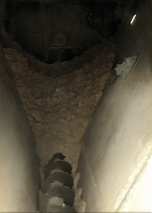With an Overhauled Dust Collection System, They are Breathing Easier at CertainTeed
By Sandia Harrison, Director of Marketing, FPE Automation
FPE Automation recently helped to reengineer a dust collection system at CertainTeed®, North America's leading brand of exterior and interior building products, as part of a corporate energy-saving incentive program. Naturally, they expected to reduce energy consumption and lower energy bills. What they didn't expect was a system that is safer, more cost-effective, and breaks down far less often.
The "Pressure" Was On
With the corporate energy-saving incentive in place, the plant engineer, Gary Hoelscher, knew he needed to find a solution right away. The timing couldn't have been better. FPE Automation's Cody Schmelzle, Solution Specialist, sent an email to Gary Hoelscher. Hoelscher responded immediately and invited him in to talk about a dust collection system overhaul.
When I reached out to FPE Automation's in-house specialist, Steve Carrera, Applications Engineer, who was called in to work on the project alongside Cody Schmelzle, Automation Solution Specialist for FPE Automation, the news had just been released that the pair had won an industry award for their success with this application. Carrera was happy to discuss what transpired at CertainTeed with me.
"The plant engineer, Gary Hoelscher, informed Cody and me that CertainTeed had an incentive for projects that helped the company save energy," Carrera told me. "Gary was willing to move forward but was not very familiar with the technology of the dust collectors since that part of the plant was handled by an engineer that was no longer with the company."
Carrera had heard that a similar upgrade had just taken place at one of the company's other locations in Florida. "I suggested that Gary get in contact with his counterpart at the sister plant to talk about what they had accomplished there."
While Hoelscher did his research, Carrera went to work on diagnostic tests. He used tools from Wixom, Michigan-based MAC Valves and FPE Automation have to analyze the efficiency of dust collection systems. MAC Valves created and manufactures the world's only diaphragm-free pulse valve. Carrera thought it would be an excellent fit for this dust collection application. He also toured the Jonesburg, Missouri-based plant.[boc_spacing height="10px"]
"You could hear the audible leak."
Carrera conducted a bleed-down test to determine the air loss for the dust collector. The test indicated that there was a drop in air pressure and that he had a leak of at least 1/8 inch. He found that the dust collector was problematic, with audible leaks and misfiring diaphragm valves.
Carrera then prepared a presumptive ROI for Hoelscher to present to management. Remember, the incentive was to reduce energy usage. There was enough compelling information about increased efficiency in the report to warrant management's immediate approval. The energy-saving upgrade was going to move forward.
This is where the story took a dramatic turn. Details began to emerge that indicated that energy savings would not be the only benefit of the upgrade.
Operations that produce dust as a byproduct of their processes rely on an industrial dust collection system to provide clean air to the workplace, ensure the health and safety of employees, and comply with EPA, OSHA and NFPA regulations. However, the dust collection system itself could be a source of danger if it isn’t properly equipped and maintained.*
Most companies are aware of the fire hazard risks of an improperly constructed/maintained dust collection system. Explosion prevention is certainly the number one concern. Efficient valves are just a part of keeping your dust collection system safe. Increasing their efficiency in measurable ways can reduce the amount of buildup in your hopper.
Another aspect that isn't as often considered is maintenance safety. When inefficient valves break down, repairs are needed. Retired engineer and 35-year FPE Automation veteran Dan McCullough, once put it to me this way; "you don't want a worker on a ladder in the snow and ice because your diaphragm valves are breaking down". McCullough for his charmingly direct style, and he has a point. MAC Valves' patented technology is proven to break down exponentially less than legacy valves. When we hear that, we tend to focus on the performance benefits. However, there are safety benefits to that statement as well.
MAC Valves Patented Technology
MAC Valves obtained a patent for a unique design that features no internal diaphragm. The result is a robust valve that has been tested/proven to outperform legacy valves. Rubber diaphragms are susceptible to tearing and grow brittle and rigid over time. With MAC's diaphragm-free patented bonded spool technology, breakdowns are a rarity.
How do MAC Valves Compare to Legacy Valves?
 |
| An empty hopper, at a different company, in an unrelated case: The valves were running, and energy was being consumed, but they were misfiring, so no airborne contaminants were being collected. |
 |
| As soon as the system was started with the new valves in place, it immediately began to collect airborne contaminants at a rate it never had in the past. |
in amounts that far exceeded the efficiency the legacy system had, even when running smoothly.
What Does Field Test Data Show?
[caption id="attachment_4446" align="alignleft" width="214"] As soon as the system was started with the new valves in place, it immediately began to collect airborne contaminants at a rate it never had in the past.[/caption]Case study after case study has shown there is a 20-30% increased expenditure in energy costs to operate a diaphragm valve, versus a MAC pulse valve.
For additional data, I e-mailed Anthony Bonadio at MAC Valves. Bonadio is MAC's resident expert in pulse valve technology. He resides in Michigan, but responded from Korea, where he is currently traveling on business. He replied, "MAC has developed a solution that replaces 60-year-old diaphragm pulse valve technology. It requires less maintenance, consumes less energy –it even extends filter life. And for most of our customers, the payback is less than a year."
* Source: Industrial Safety & Hygeine News (ISHN)






